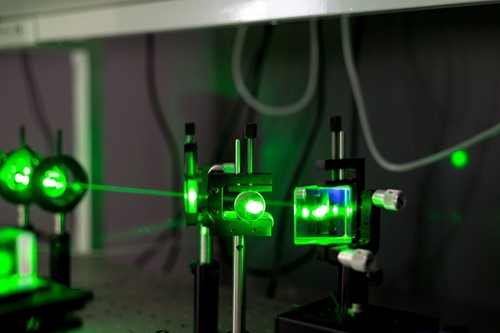How to calculate the peak power of a pulsed laser
Wednesday, December 06, 2023
Wednesday, December 06, 2023
Our blog post this week is the first in a series we call “Laser experts”, in which the Gentec-EO crew shares its best tips and knowledge about laser beam measurement. This is an unique endeavor in our market that will most certainly help many people out there in measuring lasers properly, while also learning about them generally.
As a first topic, we will be discussing how to calculate the peak power and peak power density of a pulsed laser. The latter, in particular, has quite some importance when it comes to laser beam measurement using thermal-based technology.
Peak power is formally defined as the maximum optical power a laser pulse will attain. In more loosely-defined terms, it is an indicator of the amount of energy a laser pulse contains in comparison to its temporal duration, namely pulse width.
A laser with high peak power is one that has pulses that are either high in energy per pulse or short in pulse width, but generally, both conditions are combined.
For a flat top beam, this is mathematically represented by:

Note that for a Gaussian beam, one can apply a factor of 2 to represent the actual peak power generated in the middle of the beam.
In turn, peak power density is defined as peak power divided by the area covered by the laser spot. Note that peak power is quite different from average power, the latter being loosely-defined as the amount of optical energy a laser produces each second. Peak power has no real significance when it comes to a CW laser.

Values for both peak power and peak power density for most lasers are typically immense due to the prevalence of fast laser sources on the market. Even ultrafast lasers are now a thing! Therefore, it is quite possible to hear about a gigawatt laser, or even a petawatt laser, as a reference to the peak power values these lasers can reach.
Ensure you purchase the most optimal solution for your measurement needs with this checklist. Download it now, it's helpful and free!Buyer's checklist for laser power & energy meters
We provide peak power density threshold values for most laser power detectors, thanks to a simple calculation relating energy density threshold to the former. To be specific, energy density divided by pulse width will return a peak power density value, yet, energy density threshold diminishes as pulse width gets shorter.
Consequently, this implies that lasers with an energy density level that is within the safe range of a laser power meter or a laser energy meter will also be within the safe range in regards to peak power density.
Gentec-EO's peak power and peak power density calculator is publicly available and free to use. Bookmark the page and use it whenever it can save you time.
We have discussed already that energy can be both concentrated spatially (energy density) and temporally (peak power), but also both at once (peak power density). It is therefore wise to describe the effects of high peak power density (and therefore energy density) on a detector, along with some precautions for people to consider.
One can imagine that such concentrated energy will literally vaporize the absorber if precautions are not taken. Two simple tips you should consider, if you are having trouble, are:
Finally, note that some laser parameters can be deceitfully low in a certain setting, yet danger is still quite present.
A good example would be an ultrafast laser with relatively weak energy per pulse. Imagine a 100-μJ laser with a 10-fs pulse width, along with 1 cm2 spot size. The energy density here is quite low: less than 1 mJ/cm2 in fact, which looks like it might be within the specifications of our baseline H absorber.
However, peak power density here would be 10 GW/cm2, which is huge! In this example, a solution with W or VR absorber would have been much better (or the usage of QED attenuator with an energy meter). In this example, the relatively weak energy density level misled us into thinking we would be fine until we considered pulse width into the picture (and therefore peak power density)!
There you go! This is what the experts had to say on peak power and peak power density.
Now you know how to calculate the peak power of your pulsed laser. You have learned here how to deal both mathematically and experimentally with peak power to ensure you are working in a safe and efficient environment.
Got a topic you want the experts to discuss? Comment down below, and feel free to leave any question that you may have about the current post while you’re there!